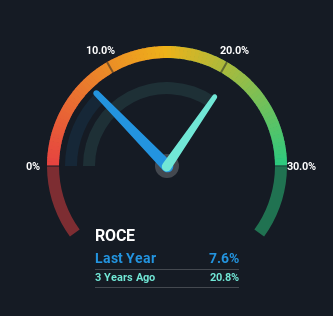Nu Skin Enterprises (NYSE:NUS) Could Be At Risk Of Shrinking As A Company
When researching a stock for investment, what can tell us that the company is in decline? A business that's potentially in decline often shows two trends, a return on capital employed (ROCE) that's declining, and a base of capital employed that's also declining. Ultimately this means that the company is earning less per dollar invested and on top of that, it's shrinking its base of capital employed. In light of that, from a first glance at Nu Skin Enterprises (NYSE:NUS), we've spotted some signs that it could be struggling, so let's investigate.
Our free stock report includes 2 warning signs investors should be aware of before investing in Nu Skin Enterprises. Read for free now.What Is Return On Capital Employed (ROCE)?
For those who don't know, ROCE is a measure of a company's yearly pre-tax profit (its return), relative to the capital employed in the business. The formula for this calculation on Nu Skin Enterprises is:
Return on Capital Employed = Earnings Before Interest and Tax (EBIT) ÷ (Total Assets - Current Liabilities)
0.076 = US$90m ÷ (US$1.5b - US$297m) (Based on the trailing twelve months to December 2024).
Therefore, Nu Skin Enterprises has an ROCE of 7.6%. Ultimately, that's a low return and it under-performs the Personal Products industry average of 11%.
Check out our latest analysis for Nu Skin Enterprises

Historical performance is a great place to start when researching a stock so above you can see the gauge for Nu Skin Enterprises' ROCE against it's prior returns. If you're interested in investigating Nu Skin Enterprises' past further, check out this free graph covering Nu Skin Enterprises' past earnings, revenue and cash flow.
What Does the ROCE Trend For Nu Skin Enterprises Tell Us?
In terms of Nu Skin Enterprises' historical ROCE movements, the trend doesn't inspire confidence. To be more specific, the ROCE was 19% five years ago, but since then it has dropped noticeably. Meanwhile, capital employed in the business has stayed roughly the flat over the period. This combination can be indicative of a mature business that still has areas to deploy capital, but the returns received aren't as high due potentially to new competition or smaller margins. So because these trends aren't typically conducive to creating a multi-bagger, we wouldn't hold our breath on Nu Skin Enterprises becoming one if things continue as they have.
The Bottom Line On Nu Skin Enterprises' ROCE
All in all, the lower returns from the same amount of capital employed aren't exactly signs of a compounding machine. Unsurprisingly then, the stock has dived 73% over the last five years, so investors are recognizing these changes and don't like the company's prospects. Unless there is a shift to a more positive trajectory in these metrics, we would look elsewhere.
If you want to know some of the risks facing Nu Skin Enterprises we've found 2 warning signs (1 makes us a bit uncomfortable!) that you should be aware of before investing here.
While Nu Skin Enterprises isn't earning the highest return, check out this free list of companies that are earning high returns on equity with solid balance sheets.
Have feedback on this article? Concerned about the content? Get in touch with us directly. Alternatively, email editorial-team (at) simplywallst.com.
This article by Simply Wall St is general in nature. We provide commentary based on historical data and analyst forecasts only using an unbiased methodology and our articles are not intended to be financial advice. It does not constitute a recommendation to buy or sell any stock, and does not take account of your objectives, or your financial situation. We aim to bring you long-term focused analysis driven by fundamental data. Note that our analysis may not factor in the latest price-sensitive company announcements or qualitative material. Simply Wall St has no position in any stocks mentioned.
 Wall Street Journal
Wall Street Journal